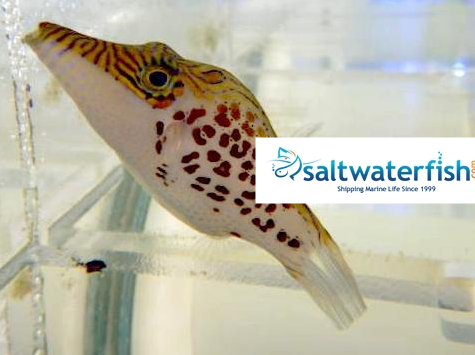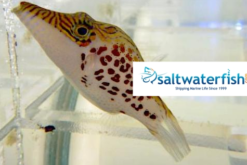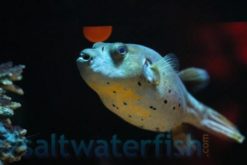Leopard Puffer (Canthigaster leoparda) – Quick Stats
- Care Level: Moderate
- Temperament: Semi-aggressive
- Diet: Carnivore
- Reef Safe: No
- Minimum Tank Size: 30 gallons
- Maximum Size: 4 inches
- Water Parameters: pH 8.1-8.4, Salinity 1.020-1.025, Temperature 72-78°F
Comprehensive Guide: Leopard Puffer (Canthigaster leoparda)
Habitat
The Leopard Puffer, Canthigaster leoparda, is found in the Indo-Pacific region, particularly in the Red Sea and the Maldives. It inhabits coral reefs and lagoons, preferring areas with plenty of hiding spots and caves.
Reef Safe
The Leopard Puffer is not considered reef safe. It has a strong beak-like mouth that can damage corals, invertebrates, and even some rock structures. It is best kept in a fish-only or predator tank.
Size
The Leopard Puffer can reach a maximum size of around 4 inches. It is a small-sized pufferfish, making it suitable for smaller aquariums.
Temperament
The Leopard Puffer has a semi-aggressive temperament. It may exhibit territorial behavior towards other fish, especially if the tank is too small or lacks hiding spots. Keeping multiple Leopard Puffers together is generally only recommended if in a large tank.
Sexual Dimorphism
There are no noticeable differences in appearance between male and female Leopard Puffers.
Lifespan
The Leopard Puffer has an average lifespan of 5 to 8 years when properly kept in a well-maintained aquarium.
Diet in Aquariums
The Leopard Puffer is a carnivorous species. It feeds on small invertebrates, crustaceans, and mollusks in the wild. The aquarium can be fed a varied diet, including frozen or live foods such as brine shrimp, mysis shrimp, and small pieces of fish or squid. It is important to offer a balanced diet to meet its nutritional needs.
Aquascaping Recommendations
When setting up the aquarium for a Leopard Puffer, it is important to provide plenty of hiding spots and caves. Use live rock structures to create caves and crevices where the puffer can retreat and feel secure. Avoid placing delicate corals or invertebrates in the tank as the puffer’s beak may damage them.
Captive Bred Availability
The Leopard Puffer is not commonly available as captive-bred. Most specimens in the aquarium trade are wild-caught. It is important to choose a reputable supplier that practices sustainable collection methods to minimize the impact on wild populations.
Compatibility with Tankmates
The Leopard Puffer can be aggressive towards smaller or more docile fish, so it is important to choose tankmates carefully. Here are five specific tankmates that can be good choices:
- Clownfish are generally hardy and can hold their own against the puffer’s aggression.
- Dottyback – Dottybacks are known for their territorial behavior, which can help establish boundaries in the tank.
- Wrasses – Some wrasses are fast and agile, making it easier for them to avoid aggression from the puffer.
- Triggerfish – Triggerfish are generally larger and more robust, making them less likely to be targeted by the puffer.
- Gobies – Gobies are bottom-dwelling fish that can occupy a different territory within the tank, reducing the chances of conflict with the puffer.
Other Common Names
The Leopard Puffer may also be known by the following common names: Leopard Toby, Spotted Toby, Guinea Fowl Puffer.
Why Buy from Reefs4Less.com
Reefs4Less.com is a reputable online saltwater aquarium livestock and supplies supplier. They have a wide selection of quality fish, corals, and invertebrates, including the Leopard Puffer. They prioritize the health and well-being of their livestock, ensuring that you receive healthy specimens for your aquarium. Their knowledgeable staff can also provide guidance and support to help you succeed in your saltwater aquarium journey.
Frequently Asked Questions about the Leopard Puffer (Canthigaster leoparda)
Q: Can the Leopard Puffer be kept in a reef tank?
A: No, the Leopard Puffer is not considered reef-safe as it may damage corals and other invertebrates.
Q: How often should I feed my Leopard Puffer?
A: It is recommended to feed the Leopard Puffer small meals multiple times a day to mimic its natural feeding habits.
Q: Can the Leopard Puffer change its coloration?
A: Yes, the Leopard Puffer can change its coloration to some extent, especially when stressed or during courtship displays.
Q: Can I keep multiple Leopard Puffers together?
A: Keeping multiple Leopard Puffers together is generally only recommended if in a huge tank with plenty of hiding spots and territories.
Q: How can I provide proper dental care for my Leopard Puffer?
A: The Leopard Puffer’s beak-like mouth continuously grows, so it is important to provide it with hard-shelled prey items or offer occasional feeding of snails or shelled crustaceans to help wear down its teeth.




Reviews
There are no reviews yet.